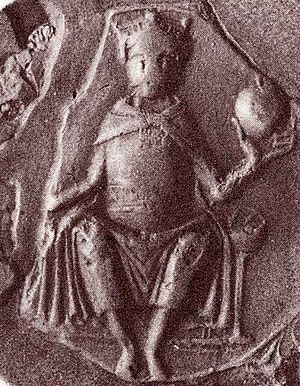Charles VII of Sweden facts for kids
Quick facts for kids Charles VII |
|
|---|---|

King Charles as shown on his seal
|
|
| King of Sweden | |
| Reign | 1161–1167 |
| Predecessor | Magnus II |
| Successor | Canute I |
| Born | c. 1130 |
| Died | 12 April 1167 |
| Spouse | Christina Hvide |
| Issue | Sverker II |
| House | Sverker |
| Father | Sverker I |
Charles VII (also known as Carl Sverkersson in Swedish) was a king of Sweden. He was born around 1130 and ruled from about 1161 until 1167. He died in a military attack led by Knut Eriksson, who then became the next king. Charles was the first Swedish king named Charles, but he is often called Charles VII in history books.
Contents
Becoming King of Sweden
Charles was the son of King Sverker I, who was sadly killed in 1156. After his father's death, another person, Eric IX, claimed to be king and ruled parts of Sweden.
However, Charles was chosen as king by the people of Östergötland around 1158. This was likely because they did not support Eric. A letter from Pope Hadrianus IV even called Charles the ruler of regnum Gothorum, which means "kingdom of the Geats."
Eric IX was later killed in 1160 by supporters of a rival named Magnus Henriksson. Magnus then ruled for a short time. But in 1161, Charles defeated and killed Magnus in a battle in Örebro. After this, Charles was recognized as the king of all Sweden. He was the first Swedish ruler to be officially called rex Sweorum et Gothorum, meaning "King of the Swedes and Götar."
Important Changes During His Rule
Charles's short time as king was very important for Sweden. Back then, Sweden was more like a group of powerful families working together. But during Charles's reign, it slowly started to become more like the organized kingdoms in other parts of Europe.
One big change was the creation of the Archbishop of Uppsala. This meant Sweden got its own main church leader. Before this, the Swedish church was under the Danish archbishop in Lund. The Pope appointed Stefan as the first archbishop after Charles and the Swedish bishops asked for it.
Charles also gave land and special rights to important monasteries like Vreta Abbey and Nydala Abbey. This shows that he was very interested in the areas of Östergötland and Småland.
During his time, the first official document that wasn't carved into stone was made. This document also had the earliest known royal seal.
Conflict with Russia
For a long time, Sweden and the Russian lands got along well. But this changed in the 12th century, and they often had fights. In 1164, Russian records from Novgorod say that Swedish forces attacked Ladoga by sea. However, Russian soldiers arrived and helped defend the city. The Swedes were badly beaten on May 28, losing many of their boats.
His Death
In the spring of 1167, King Charles was killed on the island of Visingsö. He was attacked by supporters of Knut Eriksson, who was from a rival family. Charles's young son, Sverker, was taken to Denmark for safety. Knut then took over the throne.
Charles was buried in Alvastra monastery. People remembered him as a good king. A old law book from Västergötland praised him, saying he "ruled Sweden with wisdom and goodness."
After Charles's death, his relatives, Burislev and Kol, tried to become kings in some parts of Sweden. But Knut Eriksson eventually defeated them both by about 1172–1173, and then he was recognized as king everywhere.
Family
Charles was married to Christina Hvide, who was from Denmark. Her father was Stig Hvitaleder, a powerful man from Seeland. Christina's mother was the sister of Valdemar I of Denmark, who was the King of Denmark.
Charles and Christina had one child who is known in history: a son named Sverker Karlsson. He was very young when his father died. Later, Sverker Karlsson became King Sverker II of Sweden (who ruled from 1195 to 1208 or 1210) after King Knut I passed away.
See also
 In Spanish: Carlos VII Sverkersson para niños
In Spanish: Carlos VII Sverkersson para niños

